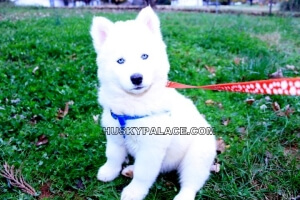The Siberian Husky breed is a strong, compact, working sled dogs.
Therefore, the medium sized head is in proportion to the body, with a muzzle that is equal in length to the skull, with a well-defined stop. The medium sized, oval shaped eyes are moderately spaced and come in blue, brown, amber, or any combination thereof. Eyes can be half blue and half brown, (parti-eyed) or can have one blue eye and one brown eye (bi-eyed). The erect ears are triangular in shape, set high up on the head. The teeth meet in a scissors bite. The tail is carried over the back in a sickle curve, not curved to either side when the dog is excited. The large “snowshoe” feet have hair between the toes to help keep them warm and for gripping on ice.
Dewclaws are sometimes removed. The medium length, double coat is thick and can withstand temperatures as low as -58 degrees to -76 degrees F (-50 degrees to -60 degrees C). Coat colors include all from black to pure white, with or without markings on the head. The facemask and underbody are usually white, and the remaining coat any color. Examples of common colors are black/white, red/white, gray/white, silver, wolf-gray, sable/white, dark gray and solid white. Piebald is a very common coat pattern.
Origin
Native to Siberia, the Siberian Husky was brought to Alaska in 1909. They were used for centuries by the Chukchi people in Siberia to pull sleds. As a result, they were perfect working dogs for the harsh Siberia conditions: hardy, able to integrate into small packs, and quite happy to work for hours on end.
The Siberian Husky is a very lightweight sled dog with great stamina. Since it was brought to North America by fur traders in Malamute for arctic races because of their great speed. In 1925, there was a diphtheria epidemic in Nome, Alaska and many dog teams relayed the precious medicine to the stricken city. Due to this event focused national attention on the Siberian husky and helped popularize the breed. Additionally, the Siberian Husky was used during Admiral Byrd’s Antarctic Expeditions. An excellent pack animal, the Husky gets along well with his comrades. Thus, Siberian Huskies have now become very popular as a companion dog, but they are also used for sledding, carting, and racing.
Temperament
These dogs are gentle and playful, but willful and mischievous. This cheerful dog is very fond of his or her family. A puppy at heart, they are clever, sociable and loving, easy-going and docile. Therefore they do generally have a lot of energy, especially as puppies.
Good with children and friendly with strangers, they are not watchdogs, for they bark little and love everyone. Huskies are very intelligent and trainable, but they have a mind of their own and will only obey a command if they see the point. Training takes patience, consistency and an understanding of the Arctic dog character. This dog will take advantage if he can. Huskies make an excellent jogging companion, as long as it is not too hot. Huskies may be difficult to housebreak. This breed likes to howl and get bored easily. Thus, they do not like to be left alone, so if this is the breed for you, you may want to consider having two. A lonely Husky can be very destructive.
Remember that the Husky is a sled dog in heart and soul. They are good with other pets if they are raised with them from puppyhood. Huskies are thrifty eaters and need less food than you might expect. This breed likes to roam. Siberian Huskies can make wonderful companions for people who are aware of what to expect from these beautiful and intelligent animals. Although there are ‘exceptions to every rule’, there are a number of breed characteristics that are generally present among members of this arctic breed. This is not meant to be a comprehensive list, as even the top breeders in the country will tell you that they learn something new about their dogs every day!
Health Problems
Huskies are relatively free of breed-specific problems, apart from hip dysplasia and occasional eye problems (such as juvenile cataracts, PRA primarily in male dogs, corneal dystrophy, crystalline corneal opacities and ectopy (displacement) of the urethra). Also, they sometimes have zinc responsive dermatitis (a skin condition which improves by giving a zinc supplements).
Exercise
Siberian Huskies need a fair amount of exercise, including a daily walk or jog, but should not be excessively exercised in warm weather. They need a large yard with a high fence.
Grooming
The coat does not need much care except during the twice a year heavy shedding season when they have to be combed thoroughly with a metal comb.
Life Expectancy
About 12-15 years.
Thanks to www.dogbreedinfo.com for this great information!







